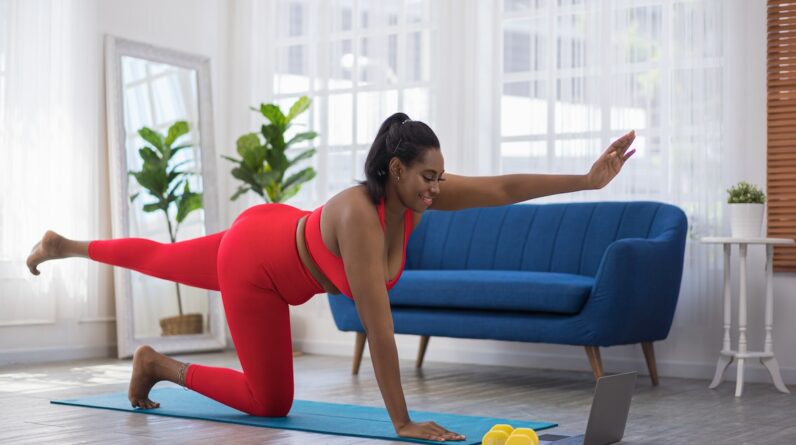
As it turns out, the position of your pelvis can affect the alignment of your whole body. “And while someone may be trying to correct their posture ‘up top,’ a pelvic tilt is often a piece of the puzzle for upper back and neck issues,” says Judith Meer, PT, DPT, a pelvic rehabilitation specialist and founder of The Pelvic PT.
Below, we’ll dive into how your pelvis influences your posture and some common misalignments to look for. Plus, Dr. Meer shares how you can create a healthy spine from the bottom up.
If you want good spinal posture, align your pelvis first
First, let’s get through some basic anatomy. Your spine has three segments: the cervical (upper) spine, the thoracic (middle) spine, and the lumbar (lower) spine, according to the University of Maryland Medical System (UMMS).
Each part of the spine relies on the strength and stability of the others to function properly. When you look from the side, a “healthy” spine curves in an “S” shape—the upper spine curves inward, the middle curves outward, and the lower curves inward—which helps lessen stress on the vertebrae, per UMMS.
The sacrum, a large bony structure that sort of looks like a shield, connects the lower spine to the pelvis. “The pelvis acts as a foundation for the spine, so its position absolutely affects your posture,” Dr. Meer says. “You’ll notice this, for example, when you curl your tailbone underneath you versus when you stick it out behind you. Both of these ‘tilts’ alter the alignment of the whole spine.”
“While someone may be trying to correct their posture ‘up top,’ a pelvic tilt is often a piece of the puzzle for upper back and neck issues.” —Judith Meer, PT, DPT
Pelvic tilts and your posture
What’s interesting is, having an anterior pelvic tilt (where the pelvis tilts forward) is pretty common. As many as 85 percent of people assigned male at birth (AMAB) and 75 percent of people assigned female at birth (AFAB) have an anterior pelvic tilt1 without any symptoms.
“An anterior pelvic tilt can create an exaggerated curve in the lower spine, which pushes the belly forward—what we call lumbar lordosis,” Dr. Meer says. “This puts additional stress on the lower back, core, hip flexors, hamstrings, and glutes.”
It becomes more difficult to stand up straight without strong, engaged core muscles supporting you, so other muscle groups will try to compensate in order to hold you up, Dr. Meer says. Specifically, you’d feel it in your upper back, shoulders, and neck. Those overworked muscles become tight and lead to more serious issues, like rounded shoulders and forward head posture.
And while less common, posterior pelvic tilts (where the pelvis tilts backward) still affect many people—6 percent of people AMAB and 4 percent of people AFAB have asymptomatic posterior pelvic tilts1.
“A posterior pelvic tilt can flatten the natural curve of your lower spine, which puts more pressure on the discs and ligaments, leading to muscle strain and pain,” Dr. Meer says. “From that, I also see tightness in the glutes and hamstrings, weak and overstretched hip flexors, and less hip flexibility.”
Interestingly, posterior pelvic tilts can also lead to excessive bending of the middle (thoracic) spine and forward head posture, according to a small 2021 study in The Journal of Physical Therapy Science.
In other words, if your pelvis is tilted, you’re probably slouching.
How to tell if your pelvis is tilted
If you think you may have an anterior (forward) tilting pelvis, try this test from the National Academy of Sports Medicine (NASM):
Put a belt around your waist and stand as you normally do while looking at yourself in a mirror from a side-view with a belt around your waist. If the belt buckle is lower than the back of the belt when you look at yourself from the side, you have an anterior pelvic tilt. In a squat, your lower back arches at the bottom of the squat.
If you suspect you have a posterior pelvic tilt, try this exercise from the NASM:
Put a belt around your waist and stand as you normally do while looking at yourself in a mirror from a side-view with a belt around your waist. With a posterior pelvic tilt, your belt buckle will be higher than the back of the belt when viewed from the side so that you can see both at the same time. In a squat, you can see a posterior pelvic tilt if the hips tuck under at the bottom of the range of motion. This is commonly known as a “butt wink.”
Building healthy posture from the pelvis up
“The ‘kinetic chain’ idea basically means that movement or alignment in one part of the body affects all of the others,” Dr. Meer says. “Working on pelvic mobility and strength can help you see improvements throughout the entire kinetic chain.”
According to Dr. Meer, there are a few things to note if you want to build good posture from the ground up:
- Check your feet. “Again, the body operates as a kinetic chain,” Dr. Meer says. “If the feet are not functioning properly, it can lead to compensatory movements in the ankles, knees, hips, pelvis and ultimately, the spine,” Dr. Meer says.
- Build a strong and balanced core. “Not just the abdominal muscles but also the rest of the ‘corset’ of muscles around the back, hips, and pelvic floor,” Dr. Meer says. “A strong core supports the pelvis and spine, reducing the risk of misalignment, pain, limited mobility, and poor posture.”
- Pay attention when you’re using technology. “There’s a reason we call it ‘tech neck’ or ‘the smartphone slump,’ Dr. Meer says. “If you notice you’re hunching over your phone, hold it a few inches higher, or adjust the height of your monitor or laptop.”
“The pelvis acts as a foundation for the spine, so its position absolutely affects your posture.” —Judith Meer, PT, DPT
3 pelvic exercises for good posture
Below, Dr. Meer shares three of her favorite pelvic exercises to help you build a stable, strong base for your spine, demonstrated by physical therapist Grayson Wickham, PT, DPT.
1. Pelvic tilt
“Pelvic tilts help you become aware of the position of your pelvis, and they gently work your lower abs and lumbar spine mobility,” Dr. Meer says.
- Lie on your back with your knees bent and feet flat on the floor.
- Slowly tilt your pelvis upward, flattening your lower back against the floor.
- Hold for a few breaths.
- Then, tilt your pelvis in the opposite direction, arching your lower back slightly off the floor.
- Do 2 to 3 sets of 10 repetitions.
2. Glute bridge
Glute bridges are a great exercise for stabilizing the pelvis because they strengthen the muscles supporting it.
“Bridges work your glutes, hamstrings, and lower back muscles, which are key to maintaining pelvic strength and alignment,” Dr. Meer says. “And I love that there are so many variations to make this more challenging, like doing it with the feet on an unsteady surface, or lifting the toes and digging in the heels, or doing single-leg bridges.”
- Lie on your back with your knees bent and feet flat on the floor, arms down by your sides.
- Press through your heels and squeeze your glutes to lift your hips off the ground, making a straight line from your knees to shoulders.
- Hold for a few breaths.
- Lower back down to starting position.
- Do 2 to 3 sets of 10 repetitions.
3. Bird dog
A strong core is key for a stable pelvis and good spinal posture. “This movement works on core stability, balance, and coordination,” Dr. Meer says. “As with bridges, you can make this harder by being on an unsteady surface, holding the arm and leg up for longer or adding weights.”
- Start on your hands and knees in a tabletop position.
- Extend your left arm forward and right leg back, keeping your hips square to the ground.
- Hold for a few breaths, then return to the starting position and switch sides.
- Do 2 to 3 sets of 10 repetitions on each side.
Well+Good articles reference scientific, reliable, recent, robust studies to back up the information we share. You can trust us along your wellness journey.
- Herrington L. Assessment of the degree of pelvic tilt within a normal asymptomatic population. Man Ther. 2011 Dec;16(6):646-8. doi: 10.1016/j.math.2011.04.006. Epub 2011 Jun 11. PMID: 21658988.
- Herrington L. Assessment of the degree of pelvic tilt within a normal asymptomatic population. Man Ther. 2011 Dec;16(6):646-8. doi: 10.1016/j.math.2011.04.006. Epub 2011 Jun 11. PMID: 21658988.
- Aramaki Y, Kakizaki F, Kawata S, Omotehara T, Itoh M. Effects of the posterior pelvic tilt sitting posture on thoracic morphology and respiratory function. J Phys Ther Sci. 2021 Feb;33(2):118-124. doi: 10.1589/jpts.33.118. Epub 2021 Feb 13. PMID: 33642685; PMCID: PMC7897525.










